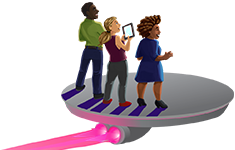DevLearn Sessions
DevLearn 2017 has the biggest, most comprehensive, most cutting-edge learning technologies program in the world. The event includes over 200 sessions covering the critical topics that will help you develop new skills and expertise in the management, design, and development of technology-based learning.
Specialized Focuses
In addition to the great tracks at DevLearn 2017 Conference & Expo, there are a number of specialized sessions curated to help you put your skills into practice immediately.

Receive hands-on training and follow along with the instructor step-by-step.

Examine the cutting-edge technologies, tools, and ideas that will shape the future of L&D.

Explore the expanded definition of L&D being formed by the intersection of emerging technologies.

Learn from your peers as they share problems, solutions, and results.

Making Measurement Work sessions focus on the practical applications of data and analytics.

Focus on skills that will take your work to new heights.
Filter By:
Sessions in Block 1
Data continues to be a hot topic in L&D. The options for collecting data continue to grow, along with the potential for finding new insights for learning design. But in conversations with L&D professionals about the need for better data, it’s become clear that good design is not only about designing for data, but also designing from data.
Read More102 The New Normal: Learning Amid the Internet of Things
Concurrent Session
The Internet of Things (IoT) technology revolution is about to explode in L&D. While still not commonplace, it has the potential to resemble the stunning uptake of the smartphone—technology that went from new to everywhere in just 10 years. It also has the capability to redefine the learning landscape. In the age of IoT, learning will no longer be about ownership of information; it will be about presence, context, and experience.
Read More103 The New Digital Learning Media: Games, Visual Stories, and Mixed Reality
Concurrent Session
Consumer experiences with YouTube, Snapchat, Netflix, console games, and virtual and augmented reality are shaping demand for a new generation of corporate digital learning. How do you develop a generation of learners who may have spent more time with video games than in school? How do you leverage the explosion of screens and devices to change behavior? How can augmented and virtual reality bring immersion, engagement, and presence to new levels?
Read More104 Case Study: A Game-Based Approach to Learning Without Lessons
Concurrent Session
An innovative product needs an innovative learning approach, but with multiple delivery options available, how do you decide which is best? The challenge for a team at Canadian Tire was to create awareness and maximize retention of an exciting new catalog among store employees. They wanted to create an engaging and innovative solution in-house but had limited time and resources. How did they decide on their approach, and what did they do to make it a success?
Read More105 Moving Past the LMS: Installing a Digital-Era Learning Ecosystem
Concurrent Session
On the footsteps of the dot-com and Y2K craze, the first web-based learning management system (LMS) OLAT debuted in 1999 as a free, open-source platform to support adult learning. It was also the same year that TiVo and Unix were released, Napster was sued by the music industry, and Amazon.com became the leading seller of books. In the almost 20 years since “LMS” entered the vernacular of learning professionals, much has changed in technology and the world at large. However, the LMS remains the central learning technology of any organization. L&D is long overdue for a change.
Read MoreCreating great online learning experiences for Americans with disabilities involves more than just adhering to US government Section 508 standards. The ability for people to navigate learning management systems (LMSs) efficiently, find course content quickly, and consume learning material goes beyond supporting screen readers alone. One strong approach is to focus on user experience (UX) design. Good UX design tactics will not only expand the accessibility of your content but also benefit all your users. Best of all, good UX design can simplify your content.
Read More107 The Next Big Thing Is Small: 20 Pros and Cons of Microlearning
Concurrent Session
Microlearning is everywhere. Your clients or L&D leaders may be pressuring you to use it everywhere. For everything. Oh, and by the way, for cheap. But when should it be used—and when should it not be used? Microlearning is a small and powerful tool, but it may not be the answer to every learning dilemma.
Read MoreIn many cases, the conceptual part of the instructional design process is neglected. Designers don’t have time; they don’t have tools; they don’t know how to ideate learning solutions in an efficient way. As a result, they end up with a routine solution aligned tightly with their own knowledge, skills, biases, and comfort zone. It is very hard to design great training based on such an approach.
Read MoreLike many roles, the world of slot machine technicians is growing more complicated and more technical every day. They have dozens of games, signs, and controllers to install and support and have several cases to address a day. How can people in situations like this keep track of it all? With their smartphone! In their hand they have access to an easy-to-use mobile tool for performance support and continuous learning.
Read MoreIn 2001, Kent Beck and others created the Agile Manifesto to address the high failure rate of projects. Since then, many companies have adopted agile principles but have struggled with the real-world challenges. Despite this change, a large number of projects still fail. The reality is, many companies talk agile, but application varies—standard techniques exist but may not be followed for good business reasons. It may be cool to be “doing agile,” but it’s just not that easy to transition.
Read More111 Lasting Impact! When Marketing Strategies Meet Learning Solutions
Concurrent Session
As the lines between marketing, communication, and training are blurring, L&D is being asked to think “like a marketer” and develop or promote creative new learning solutions. So how do marketers engage their audience and change people’s behavior despite changing technology and consumer preferences? The secret is their strategy. How can L&D professionals apply these strategies to change learner behavior and engage participants?
Read MoreWhen you visualize abstract ideas, you make the ideas easier for people to understand. When you use visual metaphors, you make content seem familiar. An important skill in L&D is the ability to make meaning through visuals—and diagrams, charts, graphs, and timelines can help.
Read MoreToday’s learners are faced with an ever-growing surplus of content to learn, process, and employ in their careers. Companies have terabytes of knowledge, skills, behaviors, and standard work required for successful day-to-day operations. They need to empower their employees with a system for efficiently building on or augmenting the capabilities each person brings to the organization. Intelligence augmentation is one possible solution.
Read MoreThe L&D landscape is a complicated space: There are dozens of genres of software, including LMSs, LRSs, authoring tools, analytical tools, etc. Yet few people understand what function their software is actually meant to accomplish. Given this fundamental misunderstanding of software’s “jobs to be done,” it’s no wonder that companies struggle to make the right purchasing decisions, often ending up with software that is not the right fit for their needs.
Read More115 BYOL: Adapt—Getting Started with an Open-Source eLearning Tool
Concurrent Session
Content designers want highly customized learning content, but that requires a developer to create custom HTML/CSS/JavaScript for each course. And this causes developers to spend too much time copying and pasting content and applying the HTML markup instead of focusing on developing the functionality. The solution is the Adapt authoring tool. This tool allows developers to create tools that content designers can use to deliver content.
Read MoreJavaScript functionality is integrated with Articulate Storyline and can be a great way to create more customizable experiences with this tool. However, many users are either intimidated by JavaScript or don’t know where to begin learning it. If you have been looking for a true beginner course that explains the fundamentals of using JavaScript with Storyline in an easy and understandable way, you just found it!
Read More









































